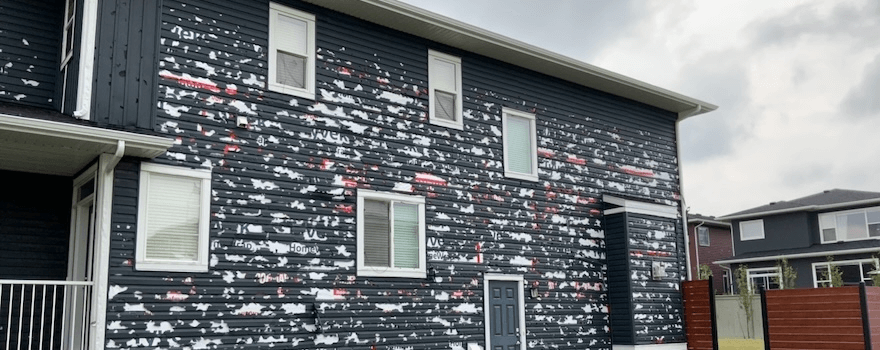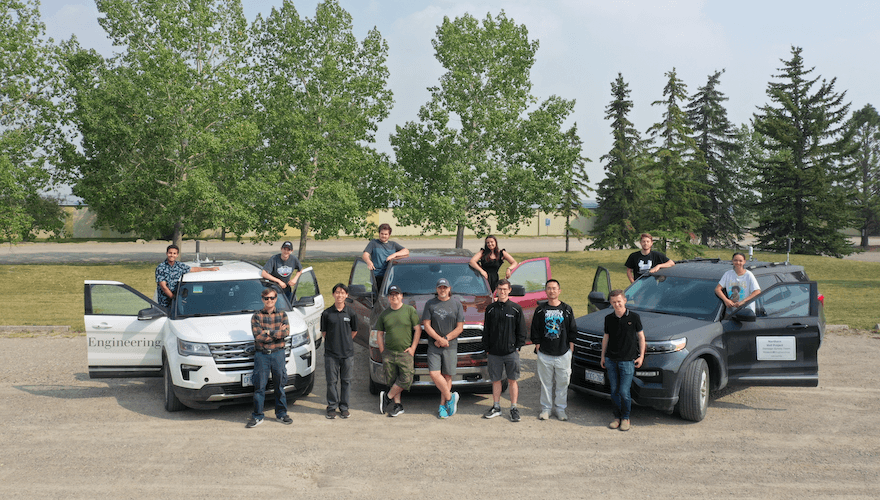CSSL Field Internship: Hail

The CSSL Field Internship: Hail is an exciting opportunity to participate in field data collection with the Northern Hail Project (NHP) in Alberta, Canada. Founded in 2022, the NHP’s mission is to advance our understanding of the meteorology, climatology, and impacts of damaging hail across Canada. To accomplish this, the NHP deploys a field team each summer to the Alberta foothills, to capture, document, and monitor hail in this region. Interns with the CSSL field internship are directly involved in collecting these important data by chasing hailstorms in real-time, conducting post-event hail damage surveys, and maintaining the NHP’s hail monitoring networks.
The NHP field team has three main objectives. The first objective is to intercept hail swaths directly behind a hail-producing thunderstorm, and to collect this hail to be studied later. The second operation aims to fly drones over the hail swath to document the dimensions and characteristics of the hail and any associated damage. Lastly, the field team also conducts post-event hail damage surveys of areas impacted by damaging hail.
This internship is based in Olds, Alberta, with travel costs covered by the CSSL. Group accommodations in Olds are also provided for the duration of the internship. High school students are ineligible for this internship, unless they are based in the Olds, AB area.
What does the "Hailswath" team do?
During deployments, the hailswath team chases hail-producing thunderstorms and positions directly behind the storm to collect hail before it melts. Members of the hailswath team will be responsible for collecting hailstones from the ground behind the storm, measuring and cataloging them before storing them in a mobile freezer to be brought back to base. This team also documents the length and width of the hail swath behind the storm.
What does the "Drone" team do?
During deployments, the UAV (drone) team chases hail-producing thunderstorms and positions directly behind the storm to fly UAVs over the hail on the ground. Multiple UAVs will be flown by the UAV team members (with training provided) to capture the size of hail on the ground and the damage done to nearby crops. When conditions don’t permit flying, the UAV team will act as a second “hailswath” team.
What does the “Damage Survey” team do?
The damage survey team is deployed after a storm to investigate hail damage to infrastructure and the environment. The team will document hail damage by measuring, taking pictures, flying drones, and speaking to property owners. The team then uses this information to generate a report on the storm and associated damage. Occasionally, the damage survey team will join the UAV and Hailswath teams to act as a second “hailswath” team.
Testimonial
Spending the past three summers working with the CSSL has been a life-changing experience for me. I was able to apply my passion for severe weather into a fulfilling work experience and a potential career. I was only a first-year Atmospheric Science student at York University when I began working for the CSSL as a tornado field intern. After two summers of travelling across Canada to survey tornado damage, in 2024 I decided to apply for the hail field internship where I worked with an inspiring and passionate team of interns and graduate students in Alberta.
I chose this internship as I have always loved meteorology and working outside, so being in the field and spending my days chasing hailstorms was a no-brainer and a dream come true. One of the best parts about working with the CSSL is the freedom that leadership provides each of the students to explore their passions and focus on tasks they are genuinely interested in, whether it's creating weekly forecasts to assist the field team or designing innovative devices to measure hailstones using radar technology. Being part of a cohesive team that collaborates so well with each other greatly elevated my day-to-day experience throughout the internship. I formed friendships with my fellow interns that will hopefully last a lifetime. Spending three months in the field chasing thunderstorms to collect hailstones and fly drones over hail swaths is challenging and sometimes exhausting work! However, I thoroughly enjoyed the unique experiences offered by working with NHP and the knowledge I gained from forecasting and analyzing hailstorms made it well-worth the long hours and late nights.
Over my 3 summers at CSSL, I learned more than I could imagine about severe thunderstorms, their hazards and impacts, and how we can better predict and mitigate damage from them. If you are particularly interested in being out in the field, don't mind long and variable hours, and can work well in a team environment with like-minded and passionate students, I highly recommend applying for the hail field internship based in Alberta where you will gain hands-on experience and contribute to advancing hail research in Canada.
Areez Habib
CSSL Field Intern: Tornadoes (2022, 2023)
CSSL Field Intern: Hail (2024)
Application
Note that applications open on December 1, 2025; and the deadline for applications is on January 26, 2026. The above links will not work until applications open.
Questions?
If you have any questions, we have made a FAQ page available for you! If you have any further questions that are not answered there, you can feel free to contact the coordinator for CSSL internships, Dr. Connell Miller, at CSSLInternship@uwo.ca.


